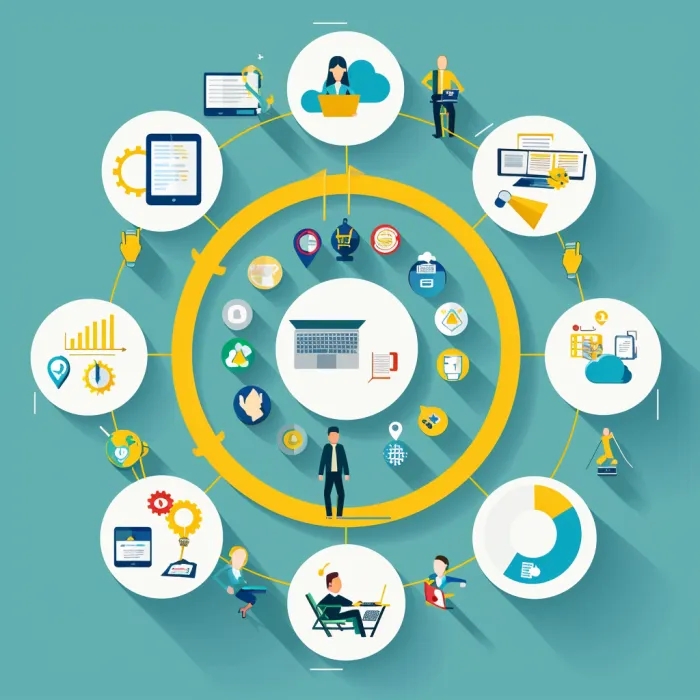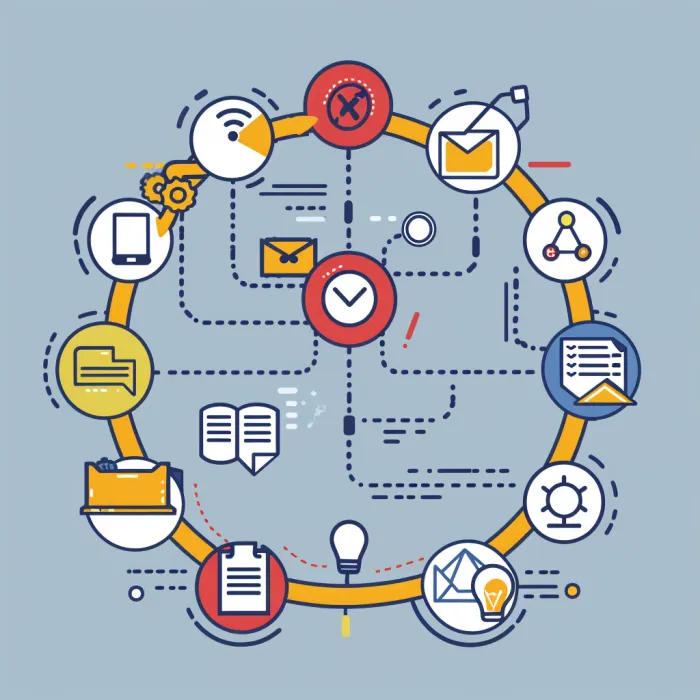Optimize Your Lifecycle Marketing Strategy in 2024: Customer Lifecycle Marketing Guide
Optimize Your Lifecycle Marketing Strategy in 2024: Customer Lifecycle Marketing Guide
In the dynamic world of marketing, lifecycle marketing has become a critical strategy for businesses looking to foster customer loyalty and drive sustained revenue growth. This comprehensive guide will delve into the intricacies of lifecycle marketing, its benefits, key components, and strategies to optimize your lifecycle marketing strategy in 2024.

What is Lifecycle Marketing?
Lifecycle marketing refers to a holistic approach that involves engaging customers through every stage of their journey with your brand. From initial awareness to post-purchase advocacy, this strategy aims to nurture and retain customers, turning them into loyal brand advocates. By understanding and addressing the needs and behaviors at each stage of the customer lifecycle, businesses can create personalized and effective marketing campaigns that resonate deeply with their audience.
Key Takeaway: Lifecycle marketing helps businesses build lasting relationships with customers, ensuring consistent engagement and fostering loyalty.
Understanding the Concept of Lifecycle Marketing
The concept of lifecycle marketing revolves around the idea of delivering the right message at the right time to the right customer. It involves mapping out the entire customer journey and identifying key touchpoints where personalized communication can enhance the customer experience. Unlike traditional marketing, which often focuses on short-term gains, lifecycle marketing emphasizes long-term customer retention and satisfaction.
Key Takeaway: Understanding the customer journey and strategically placing personalized messages at crucial touchpoints can significantly improve customer retention and satisfaction.
Key Components of a Customer Lifecycle
The customer lifecycle comprises several key stages: awareness, interest, consideration, purchase, retention, and advocacy. Each stage represents a different point in the customer's journey and requires tailored marketing strategies to move them to the next stage. For instance, during the awareness stage, the focus is on building brand recognition, while the retention stage emphasizes customer satisfaction and loyalty programs.
Key Takeaway: By identifying and targeting the specific needs of customers at each lifecycle stage, businesses can enhance customer engagement and drive conversions.
How Lifecycle Marketing Differs from Traditional Campaigns
Traditional marketing campaigns often take a one-size-fits-all approach, focusing on attracting new customers with broad, generic messages. In contrast, lifecycle marketing is highly personalized and data-driven, focusing on nurturing existing customers and guiding them through their entire journey with the brand. This approach not only boosts customer loyalty but also maximizes the lifetime value of each customer.
Key Takeaway: Lifecycle marketing's personalized and data-driven approach differentiates it from traditional campaigns, leading to higher customer retention and lifetime value.
Why is Customer Lifecycle Marketing Important?
Customer lifecycle marketing is essential because it focuses on building lasting relationships with customers rather than just acquiring new ones. By understanding the different stages of the customer lifecycle, businesses can create personalized marketing messages that resonate with their target audience. This approach not only improves customer engagement but also increases the likelihood of turning one-time buyers into loyal brand advocates.
Key Takeaway: Customer lifecycle marketing is crucial for fostering long-term customer relationships and enhancing overall engagement.
Benefits of Implementing Lifecycle Marketing Strategies
Implementing lifecycle marketing strategies offers numerous benefits, including increased customer lifetime value and improved customer retention rates. By targeting existing customers with personalized marketing efforts, businesses can encourage repeat purchases and foster loyalty. Additionally, lifecycle marketing helps identify and address operational inefficiencies, ultimately enhancing the customer experience and boosting profits.
Key Takeaway: Lifecycle marketing strategies significantly boost customer retention and lifetime value, leading to higher profitability.
Enhancing Customer Retention through Lifecycle Marketing
Enhancing customer retention through lifecycle marketing involves understanding and addressing the needs of customers at different stages of their journey. This includes offering loyalty programs, personalized marketing messages, and exceptional customer service. By focusing on customer satisfaction and engagement, businesses can create a positive customer experience that encourages repeat business and brand advocacy.
Key Takeaway: Effective lifecycle marketing strategies enhance customer retention by addressing customer needs and fostering loyalty.
Utilizing Email Marketing in Lifecycle Campaigns
Email marketing plays a crucial role in lifecycle marketing campaigns by delivering personalized and timely messages to customers. Whether it's a welcome email for new customers or a re-engagement campaign for dormant ones, email marketing helps maintain consistent communication throughout the customer lifecycle. By leveraging data and marketing automation tools, businesses can create targeted email campaigns that drive customer engagement and loyalty.
Key Takeaway: Email marketing is a powerful tool for maintaining customer engagement and delivering personalized messages throughout the customer lifecycle.
How to Optimize Customer Lifecycle Marketing
Optimizing customer lifecycle marketing involves a strategic approach to engaging customers at various stages of their journey. Businesses need to understand the unique needs at each stage of the marketing lifecycle, from awareness to advocacy. By leveraging customer data and utilizing online marketing channels, companies can create targeted campaigns that enhance customer retention and satisfaction.
Key Takeaway: Optimizing lifecycle marketing requires a deep understanding of customer needs at each stage, enabling targeted and effective marketing efforts.

Personalizing Marketing Messages to Increase Engagement
Personalizing marketing messages is crucial for increasing customer engagement. Tailoring communication based on customer data and behaviors ensures that messages resonate with the audience. This personalization can be applied across different marketing channels, including email and social media marketing. By addressing customers' specific needs and preferences, businesses can foster a loyal customer base and drive higher engagement.
Key Takeaway: Personalized marketing messages significantly enhance customer engagement and loyalty by addressing individual needs and preferences.
Implementing Marketing Automation in Your Lifecycle Strategy
Implementing marketing automation in your lifecycle strategy streamlines the process of delivering personalized messages at scale. Automation tools help manage campaigns for each lifecycle stage, from onboarding new customers to re-engaging inactive ones. By automating repetitive tasks, businesses can focus on optimizing their lifecycle marketing plan and improving customer satisfaction.
Key Takeaway: Marketing automation is essential for efficiently managing lifecycle campaigns and ensuring timely, personalized communication.
Measuring Success: Key Metrics for Lifecycle Marketing
Measuring the success of lifecycle marketing involves tracking key metrics such as customer retention rates, engagement levels, and conversion rates at each stage of the sales funnel. By analyzing these metrics, businesses can identify areas for improvement and optimize their lifecycle management strategy. Additionally, tracking customer satisfaction and loyalty indicators provides insights into the effectiveness of marketing techniques.
Key Takeaway: Regularly measuring key metrics helps businesses optimize their lifecycle marketing strategies and enhance overall customer experience.
Creating Effective Lifecycle Marketing Campaigns
Creating effective lifecycle marketing campaigns involves understanding the full lifecycle of your customer. It’s crucial to map out the different stages of the customer journey—from awareness to advocacy—and tailor marketing communications accordingly. By using marketing automation tools, businesses can deliver personalized messages at each stage, enhancing engagement and driving conversions.
Key Takeaway: Effective lifecycle marketing campaigns are tailored to the customer's journey, leveraging marketing automation to deliver personalized communications at each stage.
The Role of Content Marketing in Lifecycle Campaigns
Content marketing plays a vital role in lifecycle marketing campaigns by providing valuable information that guides customers through their journey. From blog posts and eBooks to videos and webinars, content marketing helps educate and engage potential customers at different stages of the lifecycle. This approach to marketing not only builds trust but also positions your brand as a thought leader in the industry.
Key Takeaway: Content marketing is essential for educating and engaging customers at various stages of their lifecycle, building trust, and establishing your brand as an industry leader.
Nurturing Potential Customers through Tailored Campaigns
Nurturing potential customers involves creating targeted marketing campaigns that address their specific needs and pain points. By leveraging data-driven insights and segmentation, businesses can develop tailored campaigns that guide prospects through the sales funnel. Effective customer lifecycle marketing requires a deep understanding of customer behaviors and preferences, ensuring that each interaction is relevant and impactful.
Key Takeaway: Tailored campaigns that address specific customer needs and pain points are crucial for nurturing potential customers and guiding them through the sales funnel.
Utilizing Social Media Marketing in the Lifecycle Approach
Social media marketing is a powerful tool within the lifecycle marketing model. It allows businesses to engage with customers across different platforms and stages of their journey. By integrating influencer marketing and omnichannel marketing strategies, companies can create a cohesive and compelling brand presence. Social media enables real-time interactions and feedback, enhancing customer engagement and loyalty.
Key Takeaway: Social media marketing, integrated with influencer and omnichannel strategies, is vital for engaging customers at various stages of the lifecycle, fostering real-time interactions and loyalty.
AQs
What is lifecycle marketing? Lifecycle marketing is a strategy that involves engaging customers through different stages of their journey with your brand, from initial awareness to post-purchase advocacy, with the goal of fostering long-term loyalty and driving sustained revenue growth.
How does lifecycle marketing differ from traditional marketing? Unlike traditional marketing, which often focuses on short-term goals and broad, generic messages, lifecycle marketing emphasizes personalized, data-driven campaigns tailored to different stages of the customer journey, aiming for long-term customer retention and satisfaction.
Why is content marketing important in lifecycle marketing campaigns? Content marketing is crucial in lifecycle marketing because it provides valuable information that guides and educates customers at various stages of their journey. It helps build trust, engage potential customers, and position your brand as a thought leader.
What role does social media play in lifecycle marketing? Social media plays a significant role in lifecycle marketing by enabling businesses to engage with customers across different platforms and stages of their journey. It supports real-time interactions, feedback, and the integration of influencer and omnichannel marketing strategies to enhance customer engagement and loyalty.
How can businesses optimize their lifecycle marketing strategies? Businesses can optimize their lifecycle marketing strategies by leveraging marketing automation tools, personalizing marketing messages, understanding customer needs at each stage, and using data-driven insights to create targeted campaigns that enhance customer satisfaction and retention.
What are the key benefits of implementing lifecycle marketing? The key benefits of implementing lifecycle marketing include increased customer retention, higher customer lifetime value, improved customer engagement, more effective marketing communications, and the ability to build lasting relationships with customers.
Fun Fact
Did you know? Returning customers spend 31% more on average than new customers. This highlights the importance of lifecycle marketing in driving revenue growth through customer retention and loyalty.
Inagiffy: Your Ultimate Newsletter Marketing Partner
In today's crowded digital landscape, building genuine, lasting connections with your audience is more crucial than ever.
Enter Inagiffy – a premier newsletter marketing agency that understands the transformative power of well-crafted newsletters. We're not just about sending out emails; we're about curating stories, insights, and value that resonate deeply with your audience.
Our end-to-end solutions ensure that from ideation to delivery, every newsletter reflects your brand's essence and speaks directly to your audience's needs and aspirations. Let Inagiffy empower your brand, forging authentic relationships and driving engagement through the potent medium of newsletters.
Dive into the future of meaningful communication with us and watch your audience grow, engage, and thrive.
Comments
Your comment has been submitted